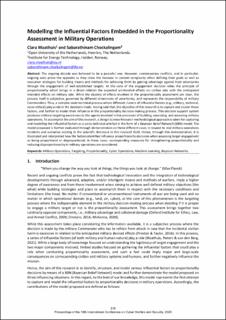| dc.contributor.author | Maathuis, Clara | |
| dc.contributor.author | Chockalingam, Sabarathinam | |
| dc.date.accessioned | 2023-10-31T09:35:37Z | |
| dc.date.available | 2023-10-31T09:35:37Z | |
| dc.date.created | 2023-08-20T22:12:25Z | |
| dc.date.issued | 2023 | |
| dc.identifier.isbn | 978-1-914587-62-7 | |
| dc.identifier.uri | https://hdl.handle.net/11250/3099662 | |
| dc.description.abstract | The ongoing decade was believed to be a peaceful one. However, contemporary conflicts, and in particular, ongoing wars prove the opposite as they show the increase in context complexity when defining their goals as well as execution strategies for building means and methods for achieving them by gaining advantage against their adversaries through the engagement of well-established targets. At the core of the engagement decision relies the principle of proportionality which brings in a direct relation the expected unintended effects on civilian side with the anticipated intended effects on military side. While the clusters of effects involved in the proportionality assessment are clear, the process itself is subjective, governed by different dimensions of uncertainty, and represents the responsibility of military Commanders. Thus, a complex socio-technical process where different clusters of influential factors (e.g., military, technical, socio-ethical) play a role in the decisions made. Having said that, the objective of this research is to capture and cluster these factors, and further to model their influence in the proportionality decision-making process. This decision support system produces military targeting awareness to the agents involved in the processes of building, executing, and assessing military operations. To accomplish the aim of this research, a Design Science Research methodological approach is taken for capturing and modelling the influential factors as a socio-technical artefact in the form of a Bayesian Belief Network (BBN) model. The model proposed is further evaluated through demonstration on three different cases in respect to real military operations incidents and scenarios existing in the scientific literature in this research field. Hence, through this demonstration, it is illustrated and interpreted how the factors identified influence proportionality decisions when assessing target engagement as being proportional or disproportional. In these cases, corresponding measures for strengthening proportionality and reducing disproportionality in military operations are considered. | en_US |
| dc.description.abstract | Modelling the Influential Factors Embedded in the Proportionality Assessment in Military Operations | en_US |
| dc.language.iso | eng | en_US |
| dc.relation.ispartof | Proceedings of the 18th International Conference on Cyber Warfare and Security | |
| dc.relation.uri | https://papers.academic-conferences.org/index.php/iccws/article/view/939 | |
| dc.rights | Attribution-NonCommercial-NoDerivatives 4.0 Internasjonal | * |
| dc.rights.uri | http://creativecommons.org/licenses/by-nc-nd/4.0/deed.no | * |
| dc.subject | Bayesiansk Tiltro Nettverk | en_US |
| dc.subject | Bayesian Belief Network | en_US |
| dc.subject | Militære operasjoner | en_US |
| dc.subject | Military operations | en_US |
| dc.subject | Proporsjonalitet | en_US |
| dc.subject | Proportionality | en_US |
| dc.subject | Maskinlæring | en_US |
| dc.subject | Machine learning | en_US |
| dc.title | Modelling the Influential Factors Embedded in the Proportionality Assessment in Military Operations | en_US |
| dc.title.alternative | Modelling the Influential Factors Embedded in the Proportionality Assessment in Military Operations | en_US |
| dc.type | Chapter | en_US |
| dc.description.version | publishedVersion | en_US |
| dc.subject.nsi | VDP::Sikkerhet og sårbarhet: 424 | en_US |
| dc.subject.nsi | VDP::Security and vulnerability: 424 | en_US |
| dc.source.pagenumber | 218-226 | en_US |
| dc.identifier.cristin | 2168291 | |
| dc.relation.project | Norges forskningsråd: 309911 | en_US |
| cristin.ispublished | true | |
| cristin.fulltext | original | |
| cristin.qualitycode | 1 | |

